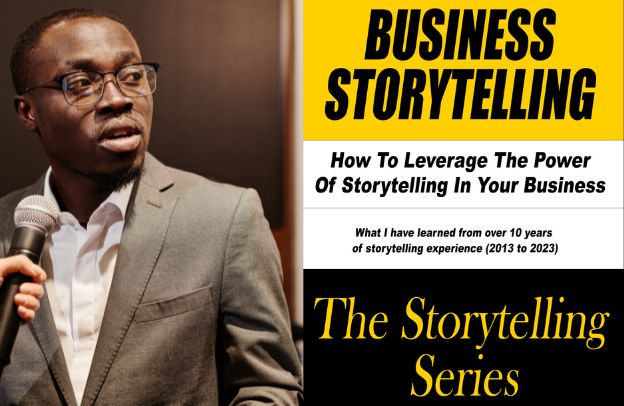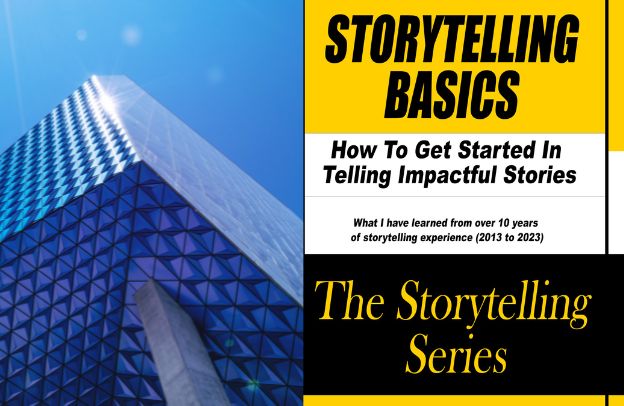Characters In Storytelling And How To Leverage It In Your Small Business

Are you struggling to make your small business stand out in a crowded market? Do you want to connect with your customers on a deeper level and build brand loyalty? Then this presentation is for you. From developing relatable characters to creating engaging narratives, The Storytelling Series for Small Businesses and Content Creators will show you how to captivate your audience and create a lasting impression.
Want to learn more about storytelling? Start by downloading the first chapter of The Storytelling Series for Small Businesses.
Today’s short read is from book two of The Storytelling Series for Small Businesses. The book is titled, WIN HEARTS & MINDS AND GET RESULTS With The 5 Essential Elements Of Storytelling and it’s available on Amazon if you want to get a copy for yourself and read along.
We are in chapter one of the book which is designed to help you understand what characters in a story are, the type of characters, character development, and how to leverage good characters in your storytelling.
This is fundamental whether you are a content creator who wants to better connect with your audience through the content you create or a small business owner who wants to elevate your brand and stand out in the competition.
What are the characters in storytelling?
Characters in storytelling are the people, animals, or other entities in a story. They can be either the protagonists or antagonists of a story. The protagonist is the main character who drives the story forward and is often in conflict with an antagonist.
The term “character” is believed by many Westerns to have come from ancient Greek χαρακτήρ meaning “mask” or “face”. It was originally used to refer to an actor’s mask in Ancient Greek theatre.
However, the term actually predates the ancient Greek and Roman eras. Instead, it can be traced back to African ancient religious practices and rituals and you don’t need much intelligence to understand this if you are a little conversant with the evolution of human history.
The following is a clip from the publication, “The Ancient Egyptian Theatre”:
“The murder of Osiris by Seth, his dismemberment and resuscitation made for excellent theatre and was frequently shown, with the main roles played by professional actors and the extras often members of the public. Abydos and Busiris were important centers for these activities.”
The festivities according to the publication were divided into three parts: the defense of Osiris by his son Upuaut, the fight of Osiris himself and his demise, and lastly the triumph of Osiris when his enemies are defeated. This is only to show you that the term character is not new by any measure of it, so, it will serve you well to understand the role of characters in your storytelling.
Do you want to create a good character in your story? Here are five things to consider:
- Well-developed and believable: One of the things that make good a character in a story is that they should be well-developed and believable, with their motivations, desires, and flaws. This is true whether in ancient African storytelling, among ancient Greeks, the Romans, or in today’s Hollywood film industry. A good character should feel like real people, rather than caricatures or stereotypes that no one would like to associate with.
- Interesting and dynamic: Good characters should be interesting and dynamic, with their unique personalities and characteristics. They should be able to hold the reader’s attention and keep them engaged in the story.
- Consistency: Good characters should be consistent in their actions and behavior so that they feel believable and genuine.
- Relatability: Do you want to create good characters in your story? Make sure they are relatable. Good characters should be relatable so that readers can identify with them and feel a connection to them.
- Memorability: Good characters should be memorable so that they stay with the reader long after the story is over. Never forget that.
Generally, the most important characters have the greatest effect on what happens in the story. Without any doubt, characters are the backbone of any story. Without them, there would be no plot and no story to speak of.
They can have a big impact on the plot, changing their role as the events in the story unfold. To make readers care about your characters, they need to have depth and change as they go through the ups and downs of your plot points. Come to think of it, that is how life is too.
Type of characters in a storytelling
There are about 7 types of characters in stories, and they are as follows:
- The protagonist,
- The antagonist,
- Secondary characters,
- Deuteragonists characters,
- The confidant characters,
- Tertiary characters,
- And the extras.
Now, let’s expand on the first three of them.
The protagonist
The protagonist is the main character of a narrative who has an important role in a story and tends to be involved in or affected by most events that take place in the story.
In a novel, a protagonist is usually the main character that typically drives the plot forward. In many cases, they are shaped by their experiences which then shape their decisions and actions throughout the story.
The protagonist must have a goal, and the whole story usually revolves around their quest.
The antagonist
The protagonist’s main opposing character is called the “antagonist.” We need antagonists so that there can be conflict, and they are found in almost every literary work you can think of.
The antagonist is generally the person or thing that is working against the protagonist’s goal. In storytelling, the protagonist is usually the hero of the story and he or she has a goal to achieve. The role of the antagonist is to stop him or her from reaching this goal.
On the surface, you might not understand the value of this as a small business owner or a content creator. But as we go deeper into this book and “The Storytelling Series for Small Businesses and Content Creators”, you will come to understand how you can perfectly lace storytelling into your marketing strategy. I am sure you will get the full picture of what we are here talking about, “the role of characters in storytelling”.
In storytelling, there are two main types of antagonists:
- One type is the person(s) who works against a protagonist because they want something that they (the antagonists) do not have and want to take it away from them. This type of antagonist will usually do anything in their power to stop the protagonist from achieving their goals.
- Another type of antagonist is the person(s) who works against a protagonist because they are simply bad people who enjoy hurting others and making life difficult for other people due to their selfish purposes.
Whichever one of them you choose to use in your story, just make sure the character is relevant within the story plot and can be relatable to the audience. The antagonist can be one character or a group of characters. In traditional narratives, the antagonist is synonymous with “the bad guy” and has been given many names throughout history, including an enemy, adversary, and opponent.
In modern times, this term has become more generalized to refer to any person who opposes another person in any way. The important point is that you should never lose track of their role in the story.
Secondary characters
Secondary characters are those in our stories who have a significant role and appear in multiple scenes, but who are not the focus of the primary plot. These supporting characters may be the focal point of their subplots.
In Romeo and Juliet by William Shakespeare, secondary characters such as Friar Lawrence, Capulet, and Tybalt all play vital roles throughout the play.
How to use characters in your small business
Storytelling is a powerful tool for small businesses to connect with their customers and build a loyal following. One way to leverage the power of storytelling is by using memorable characters. Here are some tips on how to do so effectively:
- Develop a relatable character: The character should have qualities that your customers can relate to, such as facing similar challenges, and having similar aspirations or values. Your character should embody the qualities and values of your brand.
- Create a backstory: The backstory will help your customers understand the character’s motivation and values. This backstory should also align with your brand’s values and message.
- Use the character across multiple channels: Once you’ve created your character, use it across multiple marketing channels such as social media, blog posts, and email marketing. This consistency will help to reinforce the character’s personality and message.
- Use storytelling techniques: Use storytelling techniques to help bring your character to life. For example, create a narrative arc or use dialogue to create a more immersive experience.
- Make your character interactive: Consider creating interactive experiences that allow your customers to engage with your character in a more meaningful way. This could be through a game, a quiz, or a chatbot. See, which of them that can work better for you.
By correctly leveraging the power of story characters, you can create a more engaging and memorable experience for your customers. This can lead to increased brand loyalty and a stronger connection with your target audience. So, make sure to always remember that.
Why should you develop great character in your small business?
Developing good story characters in your small business can have several important benefits. Here are some of the key reasons why it is important to focus on developing strong and memorable characters:
- Helps customers connect with your brand: A well-developed character can help customers connect with your brand on a more emotional level. When customers feel a connection with a character, they are more likely to remember and engage with your brand.
- Makes your brand more memorable: A memorable character can make your brand stand out in a crowded market. When customers remember your character, they are more likely to think of your brand when they need a product or service that you offer.
- Provides a consistent brand message: By developing a consistent character, you can ensure that your brand message is consistent across all channels. This can help to build trust with your customers and establish your brand as a reliable and trustworthy source.
- Creates a sense of familiarity: When customers feel like they know your character, they are more likely to feel comfortable with your brand. This can help to increase customer loyalty and retention.
- Increases engagement: When customers are engaged with your character, they are more likely to engage with your brand. This can lead to increased social media shares, comments, and likes, which can help to increase brand awareness and reach.
Your Takeaway
Characters are the lifeblood of any successful story, and they are what help you to better leverage the true power of storytelling in your small business.
However, you must remember that it does take time and consistent practice to develop good story characters. But the effort is always worth it in the end, especially if you are a small business owner looking to build your brand and truly connect with your target audience.
Both the literature on storytelling and the practical experiences of successful practitioners have demonstrated that by creating memorable and relatable characters, you can build a strong emotional connection with your customers and increase your brand loyalty. And if I were you, I would pay attention.
Want to learn more about “The Storytelling Series”? Then start by downloading the free chapter of the book.
The 5-part book series is also available on Amazon so you can order your copy from there. Have a good reading and remember to share your thoughts and inspiration about the series.
Want to learn more about storytelling? Start by downloading the first chapter of The Storytelling Series for Small Businesses.






